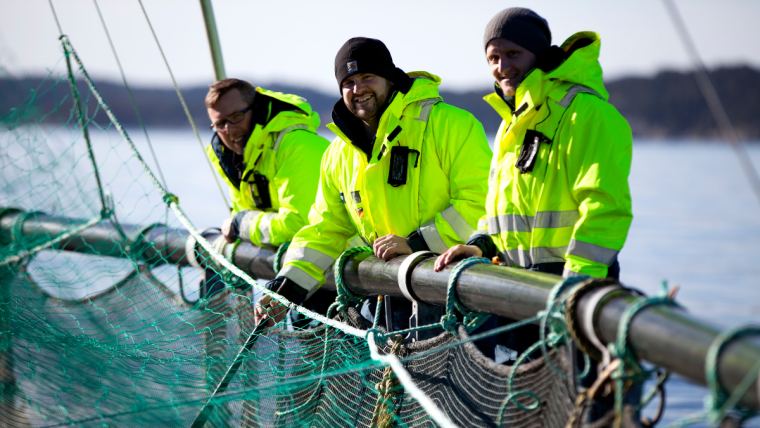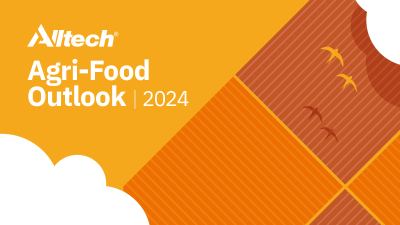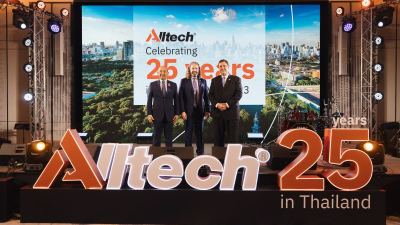Offshore and onshore: The future of the salmon industry

Can technology help salmon farmers meet the global demand for fish?
The following is an edited transcript of Nicole Erwin's interview with Dr. Oyvind Fylling-Jensen. Click below to hear the full audio.
Nicole: Can we provide the engineering solutions to meet the harsh environment of the open ocean? And can we realistically produce five-kilo salmon onshore in closed systems? I'm talking with Dr. Oyvind Fylling-Jensen, CEO of Nofima, the Norwegian Institute of Food, Fisheries and Aquaculture Research. Thank you for joining us.
Oyvind: Thank you.
Nicole: Dr. Fylling-Jensen, when we talk about engineering solutions for the fish industry, particularly salmon, are we actually talking about breeding, or is this an all-encompassing effort, from tank technology to genetics?
Oyvind: I think you have to look upon it as a value chain, where breeding and genetics are one of the input factors for producing good salmon. If your stocking materials are of high quality, your output material is more likely to be all high-quality as well. But, then, you have other input factors, like the feed, the rearing conditions and the whole way through the processing, which makes the end product, which is actually what the consumer meets. Unless that has a high quality, people won't buy it.
Nicole: How far would you say the industry has come in breeding salmon, and what are some of the end goals in breeding for the species?
Oyvind: I think, in breeding, we are starting to see some development. Historically, it has been traditional family breeding and family-line breeding. Then, over the last few years, with modern technology, you've been able to use SNP (single nucleotide polymorphism) markers and QTL (quantitative trait locus) markers for disease so that you're able to breed for disease resistance — actually, then, reducing the chances of viral diseases, for instance. Then, in the future, if you look a little bit further on, you might see a new technology, like CRISPR-Cas9, that will be pushing us even further to a disease-free salmon. So, I think we are, in convergence and developmental technology, still at the early stages of what is achievable.
Nicole: How many businesses in aquaculture would you say have access to that kind of technology right now?
Oyvind: Hundred percent; all of them.
Nicole: Oh, really?
Oyvind: Yeah, but there are two major suppliers. One is AquaGen and the other one is SalmoBreed, which is owned by the Benchmark group, and the third one is in-house breeding programs. All companies of a certain size have access to modern technology, but the research is going on both inside the industry and in research institutes and in the universities. So, there's a flow of information between the players in the field.
Nicole: How would this kind of technology increase the cost for consumers?
Oyvind: There is a limit to how much you're able to produce, and that's actually more important in determining the price to consumers than the cost of input factors, such as breeding and genetics.
Nicole: Is fast growth a challenge in breeding fish?
Oyvind: Fast growth is a challenge if you're not doing it properly because, then, you might get deformities, which reduces the output of the fish in the production cycle. You have to have a growth rate that considers the fish welfare and the robustness of the fish throughout the whole cycle, from egg to harvest.
Nicole: Is that when you know you've pushed the limit - when you do see the deformities or when there are death rates within the fish?
Oyvind: The mortality rate is still, in some farming, considered too high. Some of this is due to disease, some of it is due to environmental factors and some of the factors are still unknown. Management practices and stressing the fish, for instance, is one of the causes for mortalities, but it's not the enhanced and the forced growth that is causing the major problem. That's not the case.
Nicole: It's more with sea lice and disease?
Oyvind: Sea lice doesn't cause mortalities, per se; it causes the fish to eat less and develop stress factors that reduce the growth potential. That's one of the reasons why sea lice is considered a problem, because it also affects wild salmon and then puts pressure on wild salmon stock, and it reduces the production quality of farmed salmon.
Nicole: The potential with genomics and quantitative genetics is almost baffling to me, that we have come so far. Can you explain the difference between quantitative genetics and genomics?
Oyvind: That's slightly outside my field. The quantitative genetics uses traditional markers, like growth rate and fat and things like that. When you start looking at gene expressions and the way certain genes are causing and making susceptibility for disease, and if you were able to use genomic information to reduce that, that's when you start seeing paradigm shifts in the way breeding is done.
Nicole: How would you say that this kind of technology is shaping the industry now?
Oyvind: It's shaping the industry in the way that the speed at which new technologies and knowledge are being introduced. But then, a farmer is a farmer, and he or she will not just swap technologies or swap suppliers unless it's proven successful. So, there will be a lag phase between what is possible to do in the laboratory and what's possible to achieve on a farm site in a net pen system, for instance.
Nicole: What are some of the benefits of growing salmon onshore, compared to offshore?
Oyvind: Well, you have to distinguish between offshore in fjords — in open containment systems — or offshore in the ocean. There are completely different requirements to the equipment and to the durability and the resistance against weather and external forces. In closed containment systems and recirculation systems, land-based systems are facing challenges related to water quality, bacterial growth and disease-free environment. In some instances, there is an off flavor in the taste of the end product. But there is a lot going on. There are currently more than 20 land-based major projects under development for large-scale production — several of them here in the U.S., actually.
Nicole: Would you be able to pinpoint a couple that you think are really kind of cutting-edge?
Oyvind: I think one who is cutting-edge is a company called Atlantic Sapphire, who has a large site under development in the Everglades with the aim of producing 90,000 tons on land. What they have done is develop a system for high-quality water supply and high retention of water, good water quality and, then, also be able to dispose of all the effluence in a proper way. Another probably is Nordic Aquaculture, which is planning a site in Maine — in Belfast, Maine. Both of these companies have the advantage and they have tried out in a smaller scale and have learned some of the pitfalls; maybe, in a way, that's very expensive, because experimenting in 2,000 tons to 3,000 tons is also quite costly — but that experience is essential, I think, for their expansion into large-scale facilities where you produce 10,000 tons and more.
Nicole: Would you say that some of the benefits of producing onshore are that it allows you to control the water quality and some of those things?
Oyvind: Yeah, you have a system, and one thing is to control the water quality, but you also have to control the effluence, like nitrogen or ammonia, and to take that out of the water to have high water quality. This is one of the challenges. But, also, when you produce on land, you have to deal with sludge treatment and how you dispose of the waste, what you do with that, and energy costs. So, even though you move it on land, in closed contained land-based systems, there are new challenges that you will meet going forward.
Nicole: You had touched on parasitic sea lice a little bit before. How difficult is it managing this type of issue in salmon farming, and what are some of the control methods that you're seeing?
Oyvind: Sea lice is considered as one of the strongest markers of high-intensity production. As a kind of welfare indicator, sea lice is very good. One of the challenges with sea lice is that it has become resistant to most of the traditional pharmaceutical methods that you are trying to do. Then, since it's considered as one of the major challenges in Norway for Norwegian salmon farming, the innovation around preventive methods, like sea-based closed contained systems or lice scourge or even using lasers to “shoot” off the lice from the fish, there's a lot of development going on. Management practice is also important. Some companies are starting to develop feed with anti-lice effects so that you will not have lice infestations on the fish, but that's all in early stages. The industry says this problem will be solved in a matter of time.
Nicole: Well, how much do you actually think the nutritional diet of the fish plays into all of this, and what are they feeding to kind of control that?
Oyvind: The specific ingredients, that's the black box; that's what they're not telling us. But there are indications from research that some components that you are able to introduce to the feed will increase both the mucosal layer on the fish, which is a part of the immune system, and also introduce anti-lice signals — if I may use that kind of picture — so that lice will not jump on the fish and stay there.
Nicole: Oh, like a pheromone or something.
Oyvind: Yeah, that could be a pheromone, yes.
Nicole: Kind of like with wine, there are certain words used to describe the quality and taste of a product, whether it's bold or round or balanced, that you would use for wine. In salmon, you're looking for its robustness — is that right?
Oyvind: When you talk about robustness of salmon, it starts with the quality of the roe; it starts with the size of the smolt when you raise it in freshwater, and how strong it is, and at which size you put it into seawater. What research is now showing is that, if you are able to rear them for a longer time on land than previously done — they were put to sea around 60 to 80 grams, and now, they put them at sea around 500 to 600 grams — that you see stronger resistance toward the harsh environment that the sea really is. So that's a part of the robustness.
The other one is like genetic improvements on breeding, that you have bred disease resistance into it. The third part is quality of the feed — that, if you try to tweak the feed too much toward avoiding essential amino acids and essential minerals and things, you see a high susceptibility to disease. So, the whole picture and, also, the density of the production environment is important. So, all this is what you use, then, to describe the robust fish. Then, when you come to the wine analogy of what it looks like and tastes like, if it looks like a salmon and tastes like a salmon when you get it on the table.
Nicole: That's always a good thing. As aquaculture is expanding into other fish breeds, where do you see salmon competing in the future?
Oyvind: Salmon will remain a niche species if you look at the large volumes, in my opinion. Currently, production is around 2.2 million tons worldwide, whereas tilapia is already close to 5 million tons. If you look at all the species, like Pangasius or others, salmon will remain a fairly niche product. That's also one of the reasons why the demand for high-quality fish is exceeding the production possibility.
Nicole: So, will you be looking to a technology like gene editing to be able to meet those demands in the future?
Oyvind: I'm not quite sure if the genetic attack to it is the limitation factor. It's more about area — where to grow and how to grow — that will be the solution. That you aren't moving onshore is one solution to it. A second solution is to go offshore, into the ocean. A third solution is to use closed or semi-closed ocean- or fjord-based systems, but which are in a shape where you don't have the risk of contaminating or infecting the next laying farm, so you can actually put them much closer together than you can today. That's, in my opinion, one of the solutions to meeting increasing demand.
Nicole: Dr. Fylling-Jensen is CEO of Nofima, the Norwegian Institute of Food, Fisheries and Aquaculture Research. Thank you so much.
Oyvind: Thank you. It's a pleasure.















